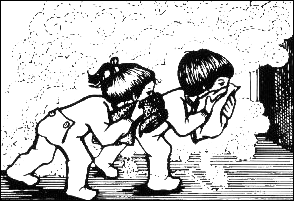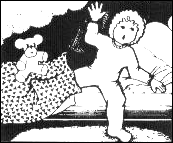Fire Safety
Teaching Fire Safety Basics at Home can Save Lives!
Even small children who are well-coached can understand what to do when the smoke alarm sounds. Thousands of children, fire-drill trained by their teachers, escape unharmed from burning school buildings every year. Little brothers and sisters need the same kind of training at home. In fact, the whole family should have an escape plan and practice leaving the house quickly and safely - just in case.
Fatal Mistakes
Most children don't know what to do when a house catches on fire. They make deadly mistakes. They rush into a smoke-filled hallway or down a burning stairway, when they might have gone safely out a window. They panic. They hide in a closet or under the bedcovers and wait for Mom or Dad to rescue them. They run back into the house to save a pet or toy. But when you teach them the basics and hold fire drills, even small children have a better chance of escaping death or injury in a house fire.
Note: Teaching fire safety basics at home can save lives.

The Basics
Here are some of the most important fire facts children should learn:
- One little match can burn down a house and kill you.
- Smoke can kill you, so you must get away from it fast.
- Fire can spread through the house in just minutes.
- If a door is hot when you touch it, don't open it - smoke or fire can rush in.
- Go out a window instead, you must get to fresh air quickly.
- Since smoke rises, upstairs bedrooms are one of the worst places to be in case of fire.
- The air close to the floor is safest for you to breathe.
- When a house is on fire, THINGS aren't important anymore, just people!
If your clothes catch fire, roll on the floor, or roll on the ground, or roll up in a blanket, rug comfortor anything large enough to choak out the flames. Don't panic and never run this will fan the flames!
Use the Approach of a Game
Using the approach of a game can help young children understand and learn the concepts of fire safety.
A game approach can make fire drills fun for small children, even though they realize that fire is serious business. They need to understand that fires can happen, but that people can get away from them, too. Then if a real fire happens, they are not nearly as likely to become confused or paralyzed with fear. They'll be better able to stay calm and get out safely and quickly, especially if they've taken part in home fire drills. Young children can learn how to open their window, climb out and go down a commercial fire escape ladder. Older children could go down hand-over-hand on a length of strong, knotted rope. Stairways can fill up with heat and deadly smoke, so it's particularly important for upstairs rooms to have a way to escape through a window.
Note: Most fires happen at night and most often in the winter months.

Your Escape Plan
When you work out your family fire escape plan, try to have at least two alternate routes out of the house. If you live in the country, have survival equipment stashed in your car, particularly in cold weather - flashlights, sweaters, sleeping bags, blankets - plus an extra ignition key hidden in the glove compartment or other safe place. Make sure, too, that your smoke alarms (preferably one in each bedroom, as well as in the main part of the house) and fire extinguishers are in working order.
Fire Drills
Trigger your fire drill with a referee's whistle, or by setting off one of your smoke alarms. Some families hang a referee's whistle over the inside doorknob in every bedroom, to be used ONLY in case of a fire emergency or fire drill. Once everyone is safely out of the house, you should all meet at the same place.
- By the car.
- Under a big tree in the yard.
- Whatever spot was agreed upon ahead of time.
After you hold several daytime drills, have a surprise drill at night, when most fires happen. Practice getting out fast. Race against the clock! Fire and smoke can engulf a house with terrifying speed. Fumes from burning synthetic wall/floor coverings and other modern home furnishings are particularly lethal. Never risk going back inside. Plan to call the fire department from a neighbor's house, once everyone is safely out.
Fire Causes
Some of the major causes of house fires is using a stove or cooking appliance carelessly or improperly. Also improperly installed and maintained heating systems, faulty wiring, careless smoking, and children playing with matches. Your chimney and woodburning stove or appliance is another deadly cause if not properly installed and maintained.
Chimney Sweeps
The good news is that professional chimney sweeps in North America make fire prevention and fire safety two of their top priorities. The skillful inspection, cleaning, repairing or relining of your chimney and a careful check of your stove hook-up could prevent a fire at your house this winter. Just make sure the sweep you hire is experienced, well-qualified and has a good local reputation.
In keeping with tradition here we are three generations of Chimney Sweeps serving Dufferin County, Caledon, Erin and Palgrave areas.
For decades people have had a love affair with wood fires, a cosy fire on a cold blustery night curled up with a good book and a warm drink is the ultimate in comfort on a winter evening. "The perfect fire" is "all woodheat can be.

Give Us a Call
Phone: 519-941-5213

Send Us an Email
thechimneysweep@sympatico.ca
Home | About Us | Services | FAQ’s | Knowledge Base | Resources | Contact Us
Website Design by Rood's Media




